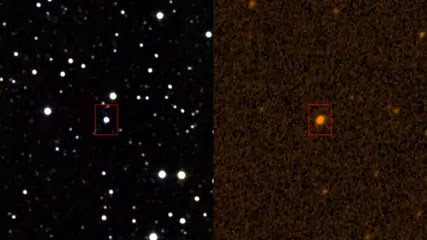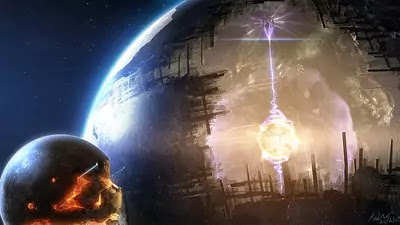Most mysterious star in the universe | Facts about KIC 8462852 | Information about Tabby's star
The Universe is mysterious, and we are trying to solve the
mysteries. In 2011, scientists were shocked by knowing about a star, and still
we are not able to get rid of the star's mystery. Many theories were emerged
about this star, but no one solved the mystery.
The star named as "KIC 8462852" is one of the mysterious star
which was discovered in the year 1890. American astronomer Tabetha S. Boyajian
was interested and invested to know about this star and therefore KIC 8462852
is also named as "Tabby's star".
Tabby's star is located at a distance of 1470 light years
away from the Earth in the constellation of Cygnus. It is estimated that,
Tabby's star may have size double than that of the Sun.
In 2009, NASA launched the Kepler space telescope to detect
Exoplanets. It used transit photometry to detect Exoplanets in detail. This
method is also helpful to detect the planet properties like atmosphere,
constituents, have life or not etc., and it will send the reports to scientists
and astronomers. Kepler space telescope discovered thousands of stars and
Exoplanets and studied them. But scientists were amazed while studying the
reports of KIC 8462852 star. The star has big dips in the brightness and they
don't know why.
 |
KIC_8462852_in_IR_and_UV_Into_the_dark_space
Image credit: Infrared: IPAC/NASA, Ultraviolet: STScI (NASA) |
On 5 March 2011, for the first time we noticed a big dip in
the KIC 8462852 star's brightness about 15%, which is mind blowing. If a Jupiter sized
planet makes transit, then the dip will be around 1% of the total light. By
this we can imagine, how much big the object was. On 28 February 2013 and 17
April 2013, again we noticed huge dips in brightness about 22% and 8%. In 2016,
in the span of 200 days the total brightness of the star decreased about 25%.
If a planet orbiting the host star makes transit, then the
brightness will decrease in a sequence. So, scientists verified and compared
the pictures captured with photographic plates in between 1890 and 1990. In
1978 and 1995, astronomers noticed the dips in brightness about 20%, but the
reports are ignored by the scientists, because they are not accurate. But
Kepler and other ground based observatories confirmed the images and given the
same reports as taken before. So, the KIC 8462852 star became mysterious.
But what is it?
As we know, if a planet makes transit, then the light curve has
a sequenced order and there is no chance to have a planet which is 7 times the
Jupiter's size. If it is more massive than that, it will become a dwarf star.
So, there is no chance to a planet which causing the bigger dips in brightness.
Meanwhile, many scientists predicted and many theories were emerged about the
Tabby's star.
Let's see about some of the theories,
1. A dust ring or a big group of asteroids orbiting the star
blocking the light reaching us. But NASA's Chandra X-Ray Observatory didn't witnessed
any dust rings around it.
 |
Dust_ring_around_Tabby's_star_Into_the_dark_space
Image credit: NASA/JPL-Caltech |
2. Some said, Tabby's star is in formation stage. So, Gas
clouds orbiting around the newly forming star blocking the light reaching us.
But gas clouds around a newly forming star will glow due to the heat produced,
and infrared telescopes can easily detect this glow. But they didn't noticed
any of the source and the researchers said, the star was actually older than
the Sun.
3. Planets and Asteroids around the star are colliding
continuously, producing huge amount of dust and blocking the light reaching us.
But infrared telescopes can detect this kind of events, but scientists didn't
noticed any of the events.
 |
Artist’s_concept_of_KIC_8462852_Into_the_dark_space
Image credit: NASA, JPL-Caltech |
4. May be one of the planet orbiting the KIC 8462852 was
swallowed by the star. When a planet is mixed up with star, it releases huge
amount of dust causing the dips in brightness. But, if a planet is swallowed by
a star, the brightness will actually increase. But there is no evidence for
increase in brightness of the star.
5. Some said, a planet orbiting the star may have huge
number of rings around it, so it can block the most of the light. But in this
case also, the light curve has sequenced order.
6. And some said, a black hole might be present in between
the star and our view, so the light curve doesn't have an order. But scientists and astronomers didn't witnessed any of the black hole in between.
Everyone made their predictions and assumptions, but no one
detected the actual object causing the dips. So finally, many scientists
concluded that the star system may have aliens, which are causing the light to
decrease.
If a star system has advanced civilizations, then they will
use the stars energy by constructing mega structures to store energy. Commonly,
these type of mega structures around a star is assumed to be Dyson's sphere,
meaning a large spherical shaped structure around a star, used to store the stars energy.
 |
| Dyson's_sphere_impression_Into_the_dark_space |
As we use the solar panels to store the Sun's energy,
advanced civilizations also use this type of mega structures to store energy and
many scientists are also agreed with this theory. Astronomer Tabetha Boyajian
also agreed with this theory.
In October 2016, SETI (Search for Extraterrestrial Intelligence) laboratories tried to detect the
signals from the Tabby's star, but they didn't detected any signals. Again in
2016, scientists tried to detect a laser signal from VERITAS gamma ray
observatory, but they didn't found any evidence.
Until now we didn't found any evidence about KIC 8462852, so
we don't know the reason behind the decrease in brightness.
What do you think?
Share your ideas and thoughts in comment section below.
For more information click here and for updates please follow my site,
Thank you.





Nyc 😍
ReplyDeleteThank you.
DeleteGud info 😍
ReplyDeleteThank you.
DeleteKummuthunnavuu kaaa
ReplyDeleteHaha, thank you.
Delete😮😯😯
ReplyDeleteGud ra
DeleteThank you guys.
DeleteGood
ReplyDeleteThanks.
DeleteGood Information...thank you😊
ReplyDeleteGood
ReplyDeletebommalu bagunnayi annaya
ReplyDeleteThank you bro.
DeleteSuperbbb
ReplyDeleteThanks.
Delete